I’d daresay that the 10x42 configuration is the most popular binocular size in the industry.
It’s an all-purpose configuration that is mostly used as a handheld for everything from birdwatching to hunting and sightseeing.
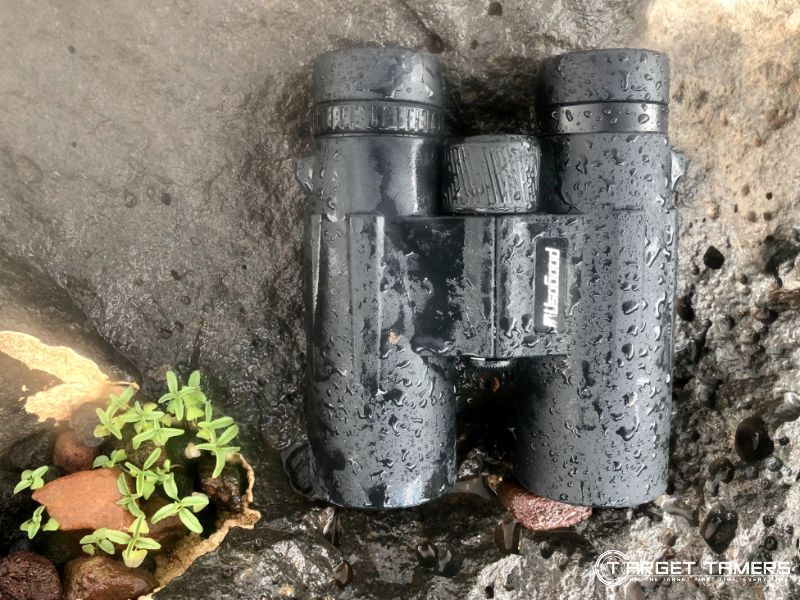
To pull together this list of the best 10x42 binoculars, I included a few that I own to compare cost, optics, build quality, size, weight, and more.
Here are my favorite 10x binoculars from field tested ones to drool-worthy binoculars I wish I had!
Why Trust Us?
After hundreds of hours of hand-testing binoculars in the field and at the range, and thousands more hours researching and writing about them, we feel we earn the title of experts when it comes to optics!
We purchase as many of the optics for our tests as possible, and run them through their paces to make sure they will perform at the range and in the field.
Our combined decades of experience from bird watching, sports and events, to big game hunting and competitions has been integral in putting together this round-up of the best 10x42 binoculars.
Get the inside scoop on how we test optics here.
The Best 10x42 Binoculars in 2024
1. Maven B1.2 10x42 – Best Overall
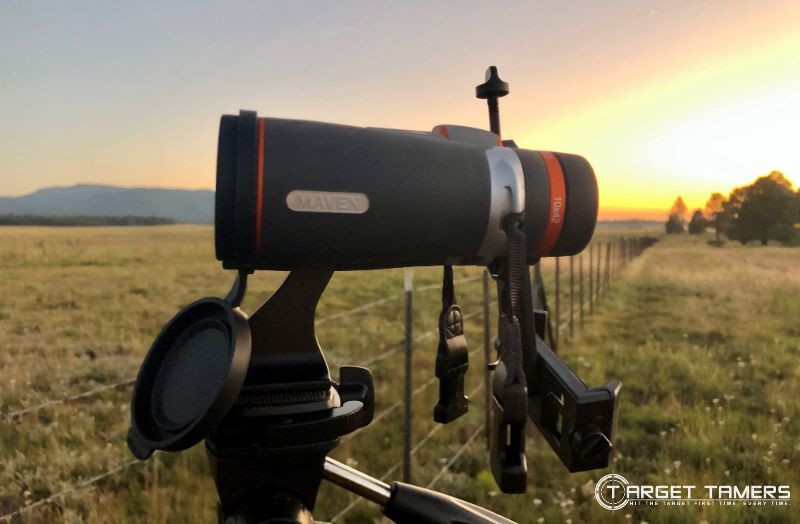
The B1.2 took over the archived B.1 line, and I can’t say that I miss the predecessor. With a greater FOV, more light transmission, longer eye relief, and a slightly more compact body, the Maven B1.2 binoculars are a star favorite.
Pros:
- WA Schmidt-Pechan prisms
- Dielectric coating
- ED glass
- Magnesium chassis
- Tripod adaptable
Cons:
- Small tripod cap
The wide-angle SP prisms give the B1.2 a wide FOV of 347 ft, but you’re also seeing a brighter, sharper, and clearer sight picture. With a 94.5% light transmission rate, 20.5 twilight factor, and ED glass with a dielectric coating on the prisms, the image quality is exceptional.

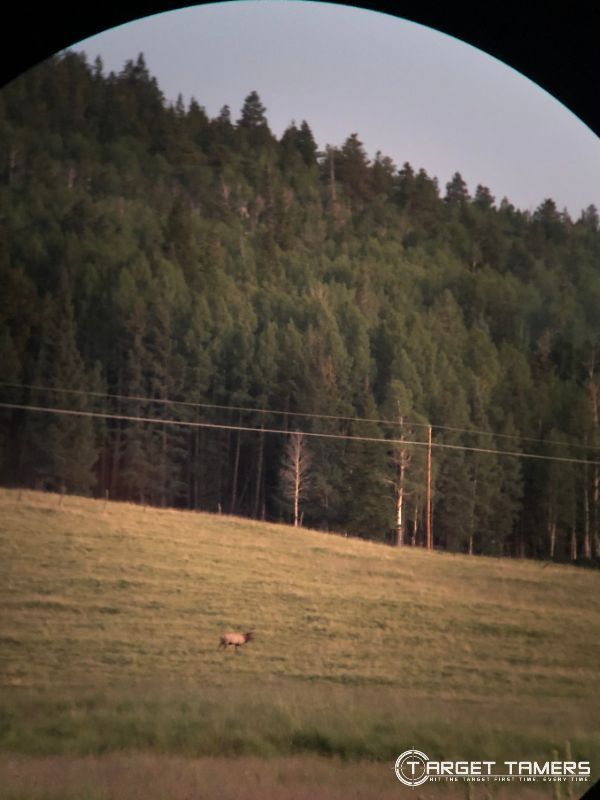
It’s so clear that the B1.2 10x42 binoculars are a personal favorite of mine for elk hunts but are fantastic binoculars for hunting in general. It’s helped me spot cow ears and bull racks hiding amongst mountain brush in first legal light. Weighing in around 27 oz, it’s not the lightest pair around, but I keep these in a chest pouch, so it’s a non-issue.
Made with Japanese materials and assembled in the US with a magnesium chassis, water-shedding and scratch-resistant armor, and an IPX7 rating, it’s definitely a high-end pair of binoculars. As such, it’s worthy of its price point and worthy as the Best Overall pair in this line-up.
2. Primary Arms GLx 10x42 – Best for Birdwatching
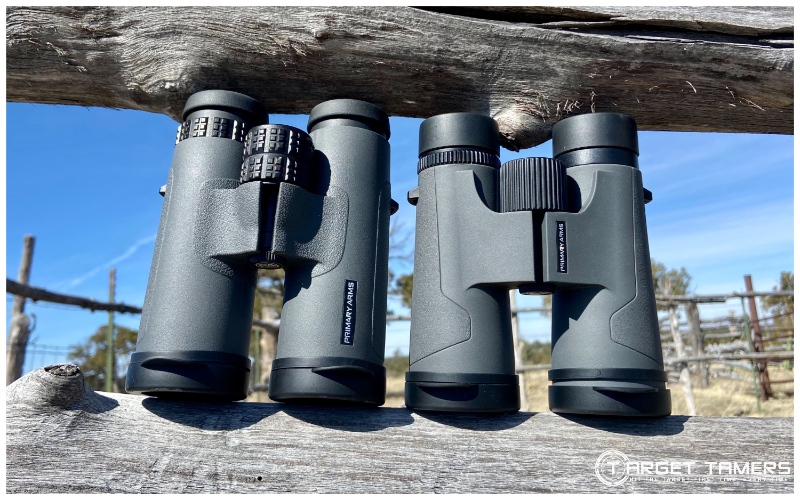
Primary Arms finally offers observation optics, and the GLx represents their standard of mid-range quality. I’m pleased to confirm this as I took this pair of binoculars to the shores, lakes, and swamps of Florida specifically for birdwatching.
Pros:
- Cost
- ED glass
- Oversized focus knob
- Magnesium chassis
- Waterproof
Cons:
- Eye relief for glasses
I’m so impressed with the GLx 10x42 binoculars. The optical quality was not what I was expecting for its low price point for binoculars under $300. The ED glass made a huge difference as it brought color and contrast on bird feathers, lurking gators, and gutted frogs. I think the photos speak for themselves.
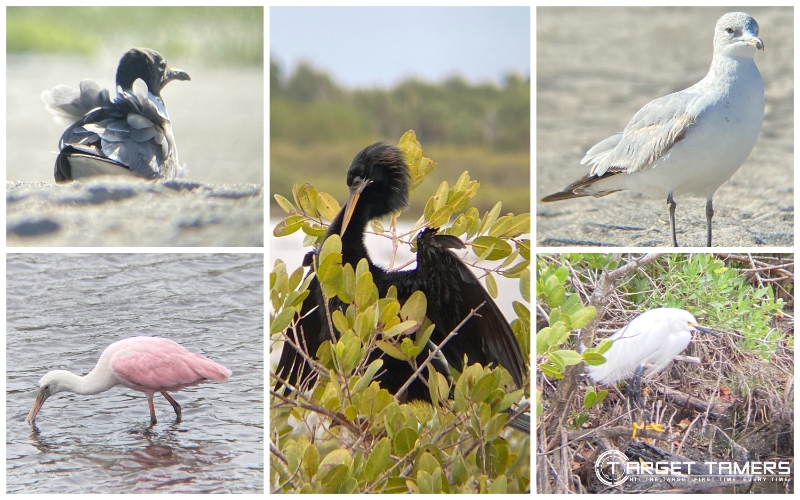
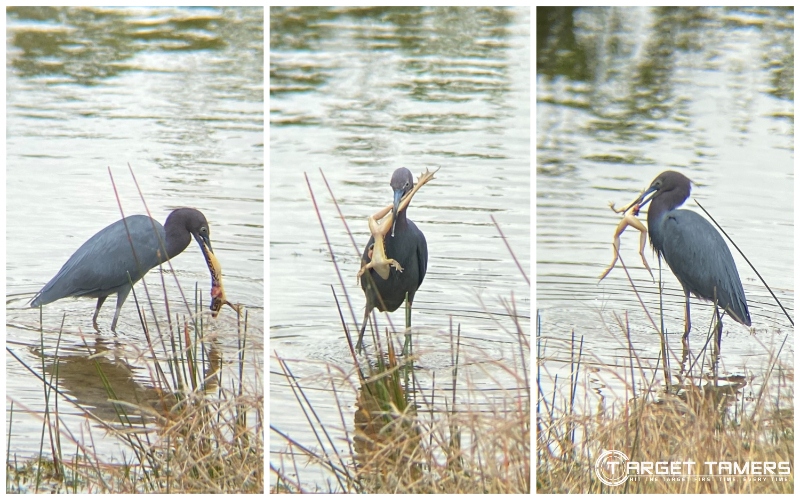
Different to the SLx 10x42 binoculars, of which I field tested as well, the GLx model has grippier knurling and a huge focus knob that’s great for two-finger use. You will want to use it liberally to bring targets at various distances into focus.
Though it doesn’t have a locking diopter, I don’t think it needs one from my experience. It’s stiff enough that I haven’t had any unintentional adjustments. Besides, it doesn’t need the price increase from one either.
The only thing that you should be aware of is that it has 15.2 mm of eye relief. With my glasses on, my frames are up against the eyecups. I can use it this way for short and quick glassing but not for the long run. Fortunately, I can use the diopter to compensate for my vision, and I’m guessing it has about -/+ 3 in dioptric adjustments.
For birdwatching, casual people watching, hunting – you name it, the GLx binoculars have my highest recommendation.
3. Swarovski EL Range 10x42 – Best for Hunting
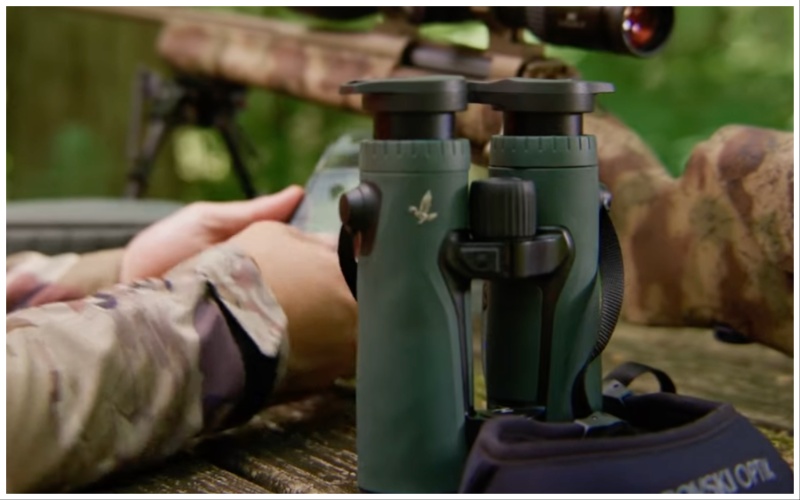
As one of the most expensive binoculars in the industry, Swarovski is a brand that everyone either wishes they had or brags that they have it. Though extremely pricey, there’s good reason the Swarovski EL Range binos reign as the victor choice for trophy, safari, and tundra hunts.
Pros:
- Rangefinder binoculars
- Tracking assistant
- Swarovision
- Independent focusing
- Angle compensation
Cons:
- Cost
- Heavy
With so many features to list, the real question is what doesn’t it have? The EL Range 10x42 is a rangefinder binocular complete with angle compensation, ranging to 2000 m, and accuracy to that distance within 2 m.
It also comes with a Bluetooth attachment so that you can transfer ballistic data (via app) and have the info you need to hit the target the first-time round. Along with the tracking assistant, you’ll essentially be able to your target or at least where you last took your shot.
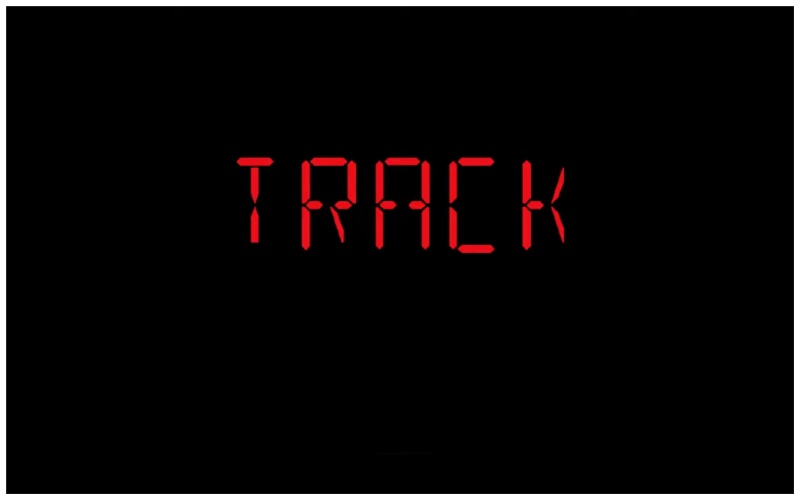
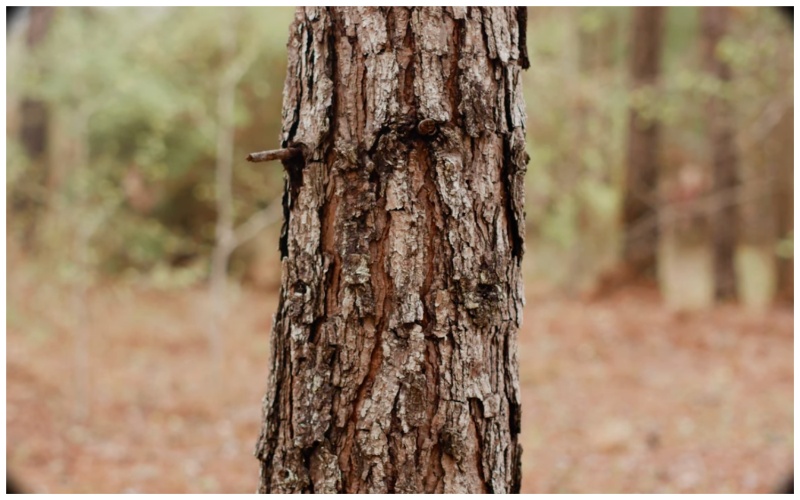
There’s not a whole lot that can be said about the optical quality other than Swarovski delivers a tack-sharp, edge-to-edge sight picture that is the standard that every manufacturer wants to meet. However, it’s hard to compete since the manufacturer keeps their materials and processes a tight-lipped secret.
A notable feature to point out is the independent focusing system for each eye. Each barrel has its own diopter, and there’s a huge dioptric range to make adjustments, -7 to +5!
But quality doesn’t come without compromise. The first is obvious. It’s jaw-droppingly expensive. The second is that it weighs in at 32.6 oz/2 lbs. This is the price to pay for greatness.
4. Zeiss Conquest HD 10x42 – Best Under $1000
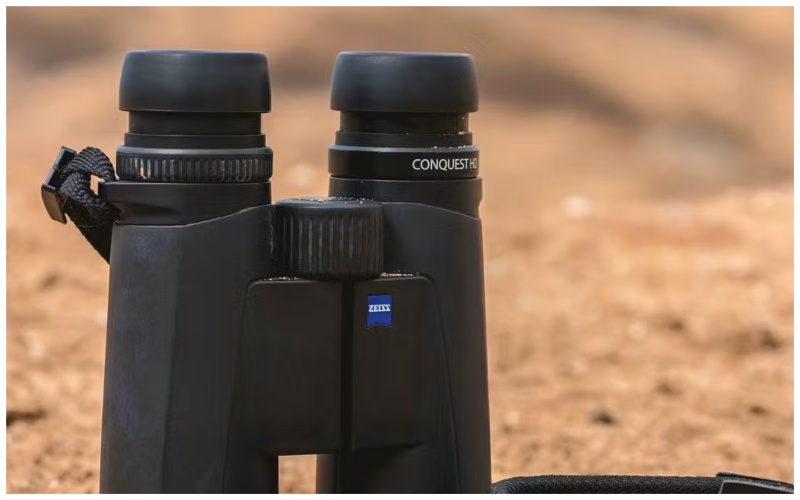
As a step above the Terra but not as expensive as the Victory, the Conquest HD is the middle ground when it comes to budget… that’s if you consider $1000 to be mid-range. With the German manufacturer’s reputation behind it, the Conquest is one of the popular binos from Zeiss to date.
Pros:
- Schott glass
- Schmidt-Pechan prisms
- ED glass
- Good dioptric range
- Made in Germany
Cons:
- Heavy
With Schott glass, 90% light transmission, T* Coating, LotuTech for the exterior lenses, and what I assume to be ED glass given its HD term, the Conquest HD binoculars are clear and bright. Designed as an all-purpose pair of binoculars, it’s often employed in the birdwatching and hunting fields.
I think one of its greatest features is that it has a good dioptric adjustment range of -4 to +4. For those who can compensate for their visual acuity via the diopter, the Conquest is likely to suit your needs.
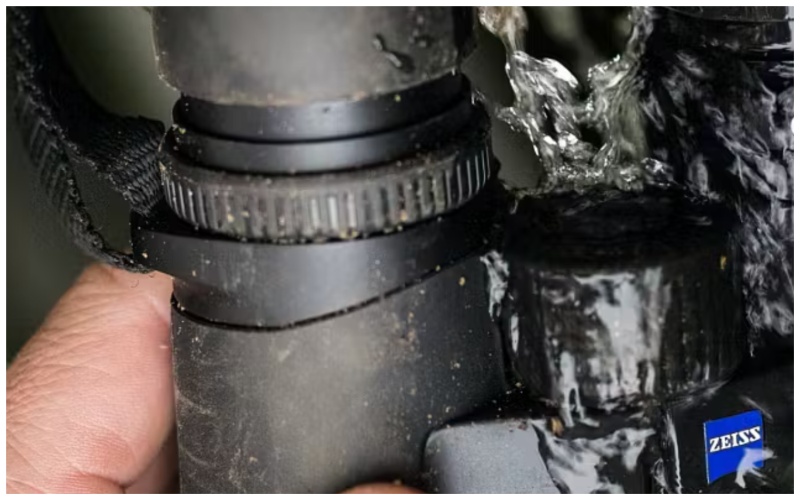
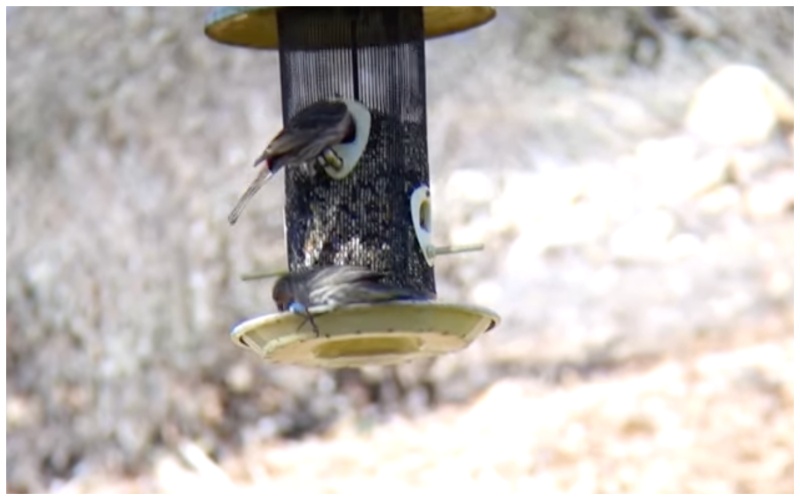
Weighing in at 28 oz, it’s on the heavier end for a 10x42 but not outside reasonable weight standards.
For the money, the Conquest HD is certainly an attractive pair of binoculars over more expensive alternatives like the Zeiss Victory or even Leica Ultravids and Swarovski ELs. Though there’s good reason to opt for pricier binos, the Conquest comes in under $1000 with performance that will satisfy many hunters, birders, and recreationists.
5. Maven C.1 10x42 – Best Under $500
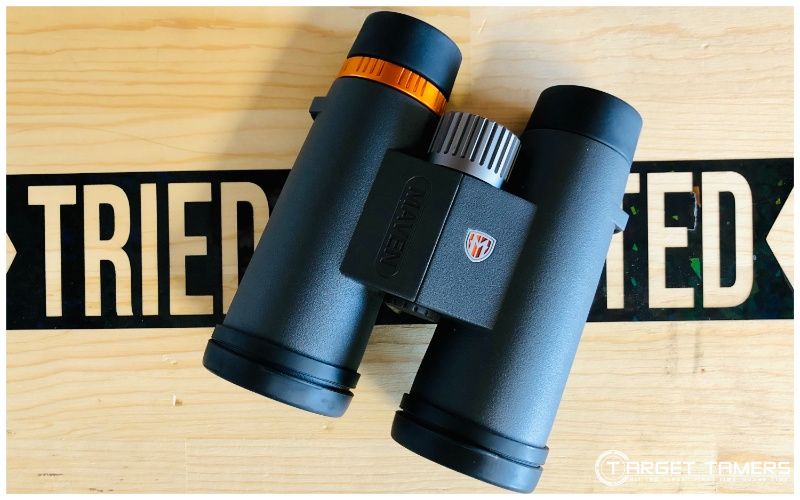
Maven has built a reputation that offers an excellent price to quality ratio. Without a middleman to increase the markup, Maven just brings awesome and rugged optics to the table. From their affordable and mid-range series, the C.1 is clearly one of the best pair of binos for under $500.
Pros:
- ED glass
- Schmidt-Pechan prisms
- Dielectric coating
- Polymer chassis
- Made in the Philippines
Cons:
- Stiff diopter
Though much is loved about Maven’s B series binoculars, the C series offers fantastic value. Still made with ED glass and Schmidt-Pechan prisms with a dielectric coating, the C.1 differs with a tough polymer chassis and is only IPX6 rated.
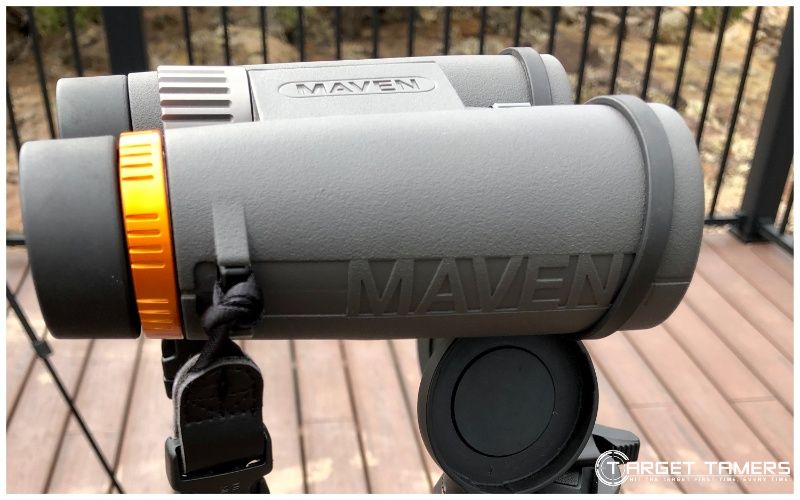
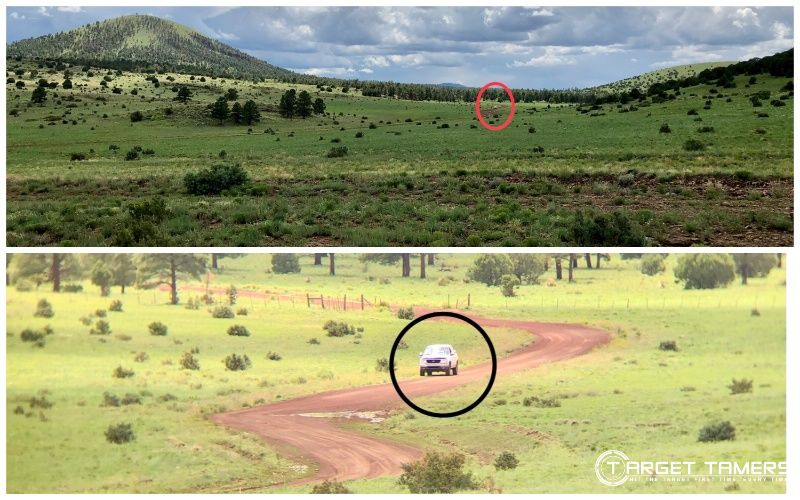
It was one of the very first binoculars we field tested by Maven, and it far surpassed similarly priced binoculars. Image flatness is fantastic with maybe some edge softening in the last 10% or so of the FOV. Color fringing is kept to an absolute minimum, and it certainly pics out antelope that blend in with the terrain.
The diopter is very stiff, but I don’t count this to be a negative. The silver lining is that there’s no need for a locking mechanism. Having been made with both Japanese and Chinese components and assembled in the Philippines, Maven found a way to bring mid-range quality as the standard for mid-range priced optics.
6. Vortex Crossfire HD 10x42 – Best for the Money
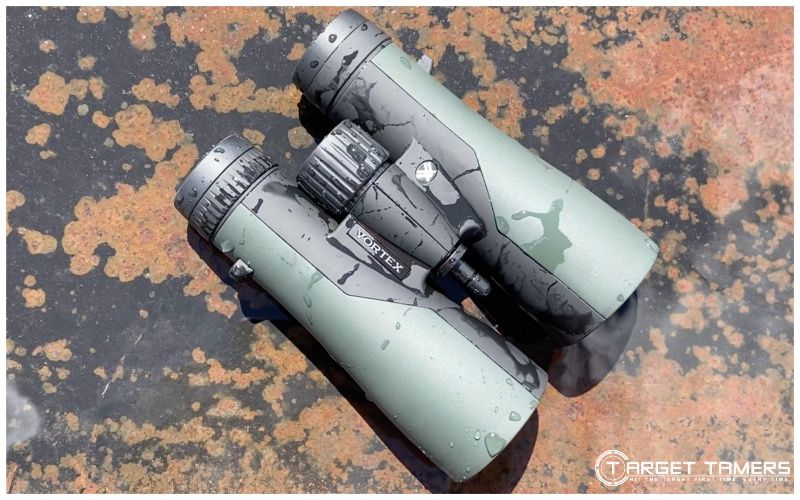
Though the Vortex Diamondback HD 10x42 would be an excellent binocular to feature here, the Crossfire HD 10x42 are far more affordable and as a result is far more popular among the masses.
Pros:
- Cost
- HD FMC optics
- Fog/waterproof
- Lightweight
- Included accessories
Cons:
- Entry-level optics
Technically, I field-tested the Vortex Crossfire HD 10x50 binoculars, but it’s fair to say that the 10x42 are only different in specs. As far as performance and durability goes, there’s little, if any, difference between the two.
The 10x42 model offers a wider FOV than the 10x50 and a lighter weight. That’s to be expected. In the field, the Crossfire HD binos were water-tested, discerned elk from boulders approx. 2000 yards away, and the movable parts are smooth and easy to use. It’s really good on heft too weighing in at only 23 oz.
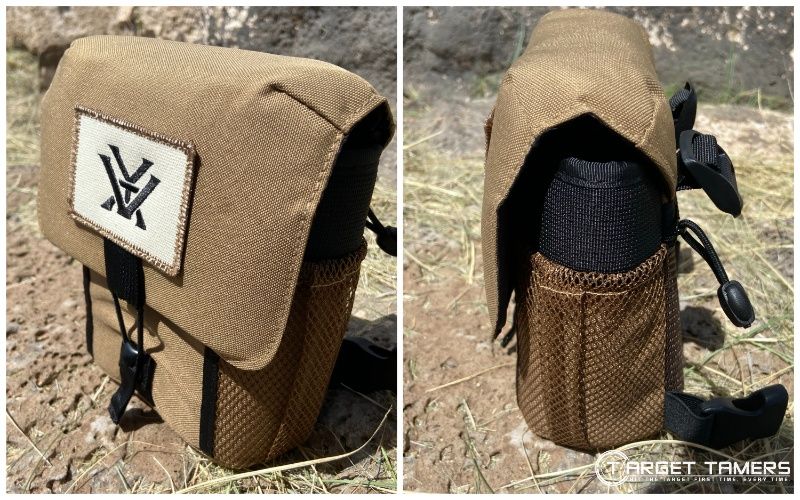

Though resolution is excellent for close-range, you must be liberal with the focus knob. I often overshot it, and there is some visible chromatic aberration. For its low price point, I’d still recommend these as budget binoculars completely on point for what I expect from entry-level optics.
I think my favorite thing about it is that it’s durable, and it’ll definitely work for recreationists, casual birdwatchers, and even hunters. The Crossfire HD binos also come with the GlassPak case and harness, and I would say this adds value to the already low buy.
A Guide to Choosing the Best 10x42 Binoculars
Cost
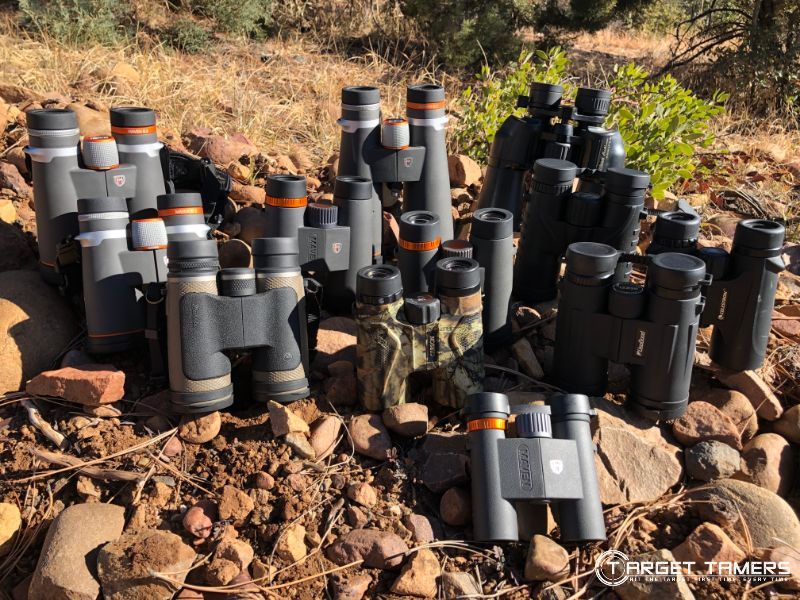
Overall, binoculars with the same configuration will not have the same price point. The cost for a 10x42 binocular will vary depending on the type of prisms used and glass elements to the frame/chassis material to the quality of the rubber armor and more. Not all binoculars are created equal.
What the trend shows is that buyers will take a chance on quality binoculars at the entry-level price point around $100-$200. People consider $300-$500 to be mid-range and anything above that is often thought of to be high-end. This anecdotal standard doesn’t always carry across to manufacturers.
There is many a good reason to learn the differences between cheap versus expensive binoculars. You’ll have a better idea of what the budget should be if you know how you’ll be using your binoculars and what its capabilities and limitations are.
| Product | Features | Price Range |
|---|---|---|
| Maven B1.2 | Best Overall | Under $1000 |
| Primary Arms GLx | Best for Birdwatching | Under $300 |
| Swarovski El Range | Best for Hunting & Safari | Under $4000 |
| Zeiss Conquest HD | Best Under $1000 | Under $1000 |
| Maven C.1 | Best Under $500 | Under $500 |
| Vortex Crossfire HD | Best for the Money | Under $200 |
Optical Quality
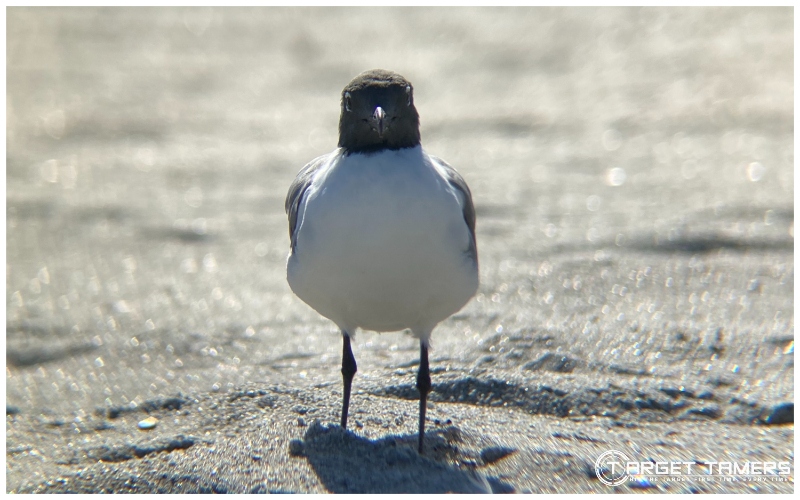
On average, a major feature that sets apart binoculars is the optics. The glass, number of lenses, prism type, prism-specific coatings, etc. are all part of how sharp and clear a sight picture can be.
Porro prisms refract light less than a roof prism, but Schmidt-Pechan prisms bend light even less than the roof design.
All roof and roof-based prisms need a special coating to reflect light. This is a phase correction coating, and without it, rarely would it be a binocular worth buying.
ED (Extra-low Dispersion) glass helps to minimize chromatic aberration (color fringing) and improves contrast.
Exterior lens coatings protect them from fingerprint smudges and dirt but also helps to repel water like when it’s raining further protecting your sight picture in inclement conditions.
| Product | Prism Type | Glass Type | Coatings |
|---|---|---|---|
| Maven B1.2 | WA Schmidt-Pechan | ED glass | Dielectric & scratch/oil resistant coatings |
| Primary Arms GLx | Roof | ED glass | FMC coatings |
| Swarovski El Range | Schmidt-Pechan | ED glass | Swarovision |
| Zeiss Conquest HD | Schmidt-Pechan | ED glass | LotuTec |
| Maven C.1 | Schmidt-Pechan | ED glass | Dielectric & scratch/oil resistant coatings |
| Vortex Crossfire HD | Roof | HD glass | FMC coatings |
Specs
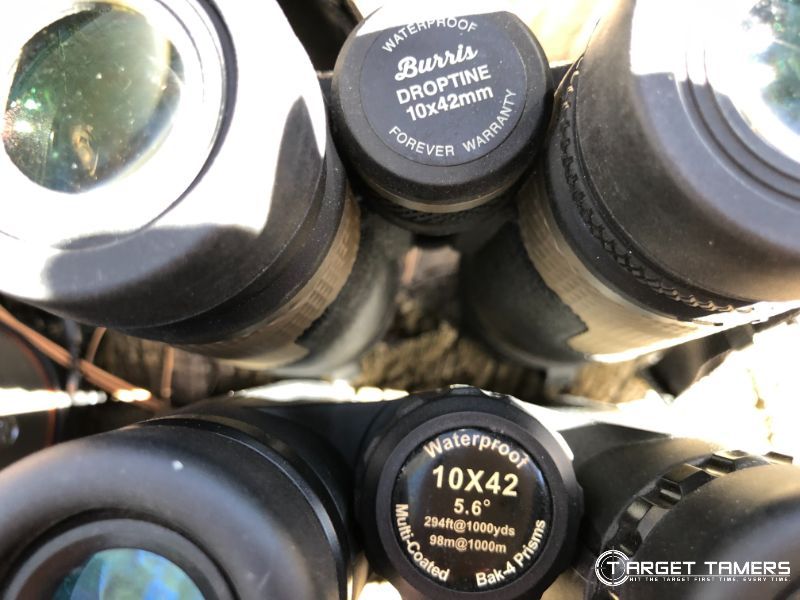
In total, binoculars with the 10x42 configuration will have identical specs on paper such as the exit pupil (4.2 mm), twilight factor (20.5), and brightness (17.6) values. However, the FOV, eye relief, close focus, and IPD will vary. These are good specs to review before buying just any 10x42.
| Product | Field of View (@ 1000 yards) | Eye Relief | Close Focus | IPD |
|---|---|---|---|---|
| Maven B1.2 | 347 ft | 17.8 mm | 4.9 ft | 56-74 mm |
| Primary Arms GLx | 341 ft | 15.2 mm | 6.6 ft | 56-76 mm* |
| Swarovski El Range | 357 ft | 19 mm | 13 ft | 56-74 mm |
| Zeiss Conquest HD | 345 ft | 18 mm | 6.6 ft | 54-74 mm |
| Maven C.1 | 314 ft | 16 mm | 5.9 ft | 58-72 mm |
| Vortex Crossfire HD | 325 ft | 15 mm | 6 ft | 58-75 mm |
*Approximately
Build Quality
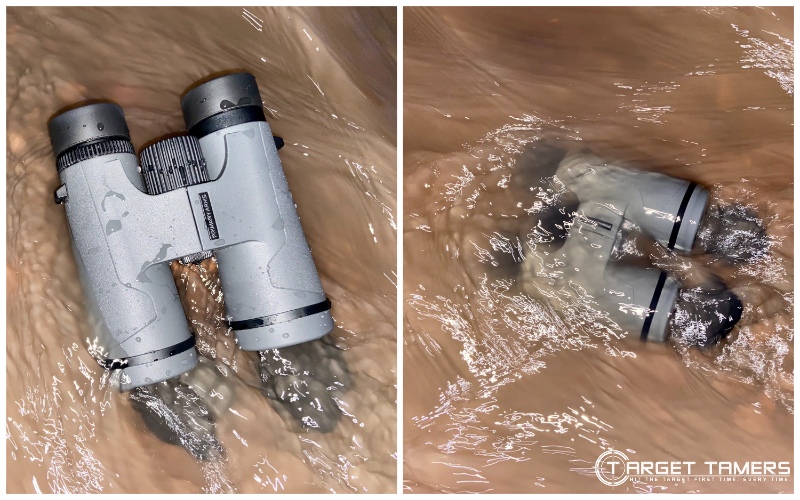
In general, recreationists often find themselves in less than perfect weather where rain, snow, and inclement weather can affect binocular performance. Even if it’s not raining, there’s moisture in the air, dirt that gets in the nooks and crannies, and accidents that happen in the field.
A strong chassis and O-ring sealed with a gas-purged housing will go a long way in making sure you have binoculars that are clear and keep the glass lenses intact and in place.
| Product | Chassis | Waterproof | Fogproof |
|---|---|---|---|
| Maven B1.2 | Magnesium | Yes | Nitrogen |
| Primary Arms GLx | Magnesium | Yes | Undisclosed |
| Swarovski El Range | Magnesium | Yes | Nitrogen |
| Zeiss Conquest HD | Aluminum | Yes | Nitrogen |
| Maven C.1 | Polymer | Yes | Nitrogen |
| Vortex Crossfire HD | Undisclosed | Yes | Nitrogen |
Size & Weight
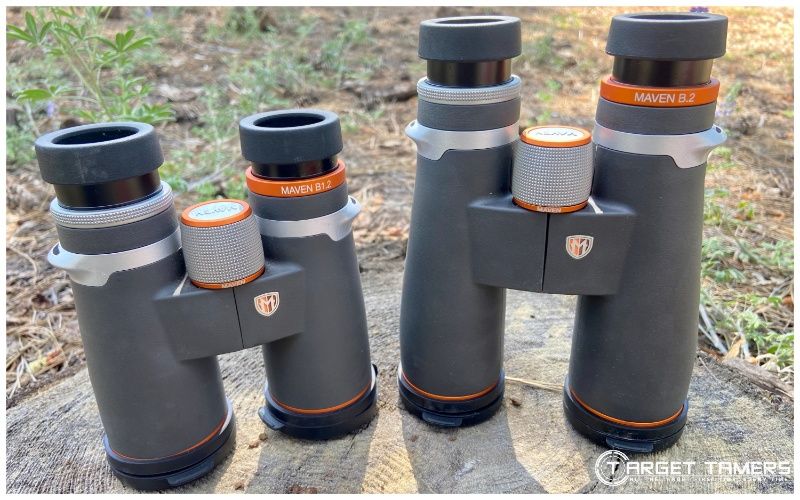
Though 10x42 binoculars have the same configuration, they’re not built the same. This can stem from the use of extra glass elements and where the optical assemblies are placed to the material used for the frame.
Though the 10x42 falls into the mid-size binocular category, their weight will have a role in whether it’s primarily a handheld binocular or if it’s better suited to tripod mounting.
| Product | Dimensions | Weight | Tripod Adaptable |
|---|---|---|---|
| Maven B1.2 | 5.2 x 5.7 x 2.2” | 26.8 oz | Yes |
| Primary Arms GLx | 5.5 x 5.5 x 2” | 23.7 oz | Yes |
| Swarovski El Range | 6.8 x 5.3 x 3.1” | 32.8 oz | Yes |
| Zeiss Conquest HD | 5.9” (L) | 28 oz | Yes |
| Maven C.1 | 5 x 5.7 x 2.1” | 24.5 oz | Yes |
| Vortex Crossfire HD | 6 x 5.2” | 23 oz | Yes |
Warranty
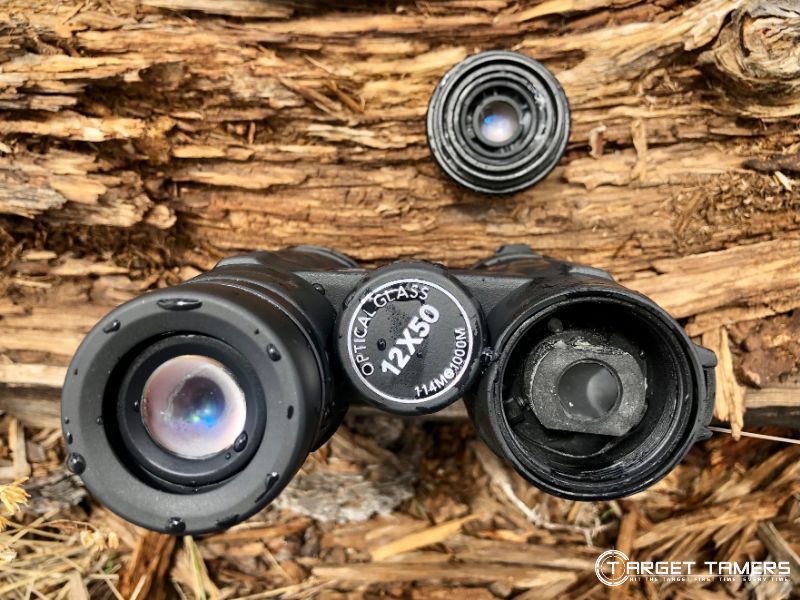
Many optics warranties are similar in that they offer lifetime coverage. However, they’re far from equal when it comes to owner transfership, proof of purchase, or registration requirements. Regardless of cost, the warranty must be considered.
| Product | Warranty | Features |
|---|---|---|
| Maven B1.2 | Unconditional Lifetime | Fully transferable, no receipt needed, no registration required |
| Primary Arms GLx | Limited Lifetime | Lifetime, fully transferable, normal wear & tear covered |
| Swarovski El Range | Limited Warranty | 10-year warranty plus 5-year warranty on electronics, proof of purchase required for warranty coverage |
| Zeiss Conquest HD | Limited Lifetime | Lifetime warranty with 5-year warranty on electronics, fully transferable, conditions apply |
| Maven C.1 | Unconditional Lifetime | Fully transferable, no receipt needed, no registration required |
| Vortex Crossfire HD | VIP Warranty | Fully transferable, no receipt needed, no registration required |
FAQ's
In general, 10x42 binoculars are considered a multi-purpose configuration that is good for many applications for beginners to seasoned outdoorsmen. It offers steady image quality and resolution at distance with only 10x magnification when used as a handheld.
Other features such as optical quality, build quality, and other specifications will determine if it’s a pair that’s best suited for your application.
On average, the 10x42 binocular is stronger than the 8x42 configuration. It offers 2x more magnification to enlarge the view. However, 8x is easier to use as a handheld with slightly less power. Though the 10x42 is ‘bigger,’ resolvable detail will come down to the optical quality of a binocular.
For more information on 8x42 VS 10x42 binoculars, check out the comparison guide!
Binoculars with the 10x42 configuration will enlarge a view by 10x. This makes the 10x42 binocular a good option for seeing stars. However, while they will bring into view more stars than can be seen with the naked eye, not much resolvable detail will be had.
Though it has the advantage of a wide field of view to find stars easily with some magnification, higher power and larger objectives will be desired. Though a spotting scope can perform better, a telescope is best suited to the job.
Both 8x42 and 10x42 binoculars serve birdwatchers well. The 8x bino offers a wide field of view to follow birds in flight and is easier to use in the hand when image stability is a must. However, the 10x bino offers a larger view especially with birds that slow-moving or have already been located.
Overall, binocular quality is to be judged by far more than just the 10x42 configuration. When comparing binoculars to meet your needs, other specs such as field of view, eye relief, and size must be considered. Additionally, the glass and overall build integrity will largely affect quality.
To learn more about the differences between budget and high-end binos, see our Cheap VS Expensive Binoculars guide!
Best 10x42 Binoculars: Which is Best for You?
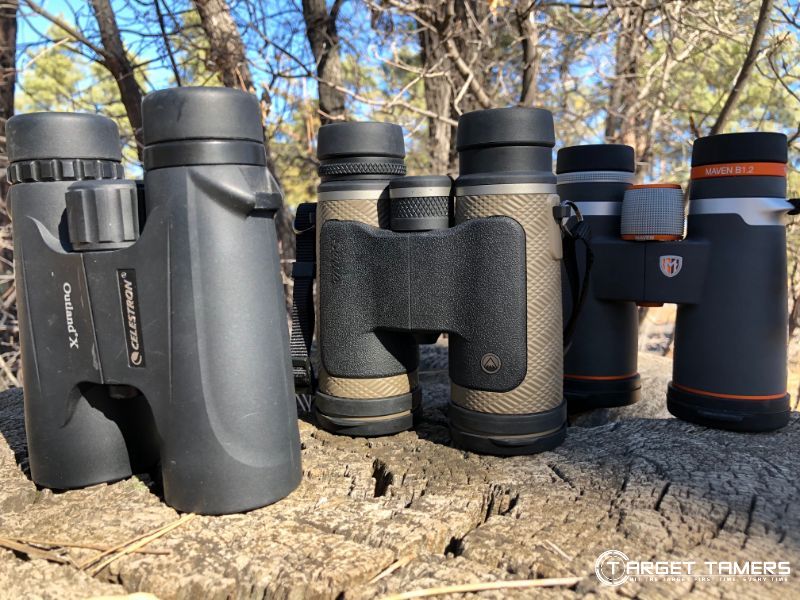
The best 10x42 binoculars might not necessarily fit the budget especially if you end up spending more than you originally had in mind. However, with glass that provides resolvable detail in the conditions when you need it most, it’s worth every cent.
My personal favorite is the Maven B1.2 10x42 binoculars for its very dependable optical quality. However, the Primary Arms GLx 10x42 binoculars offer excellent optics at a price point that is more comfortable for most. If I had the money, I’d have a pair of Swarovskis in a heartbeat.
Further Reading






